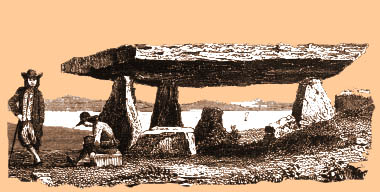 |
Origins of Bouldering |
 |
Origins of Bouldering |
Bouldering
in America . . . The Early Years
|
In
America
, the history of
bouldering
goes back at least eighty
years, but, again, it is difficult to distinguish the sport from early
top-rope practice and boulder scrambling.
The first recorded instances of bouldering in America took place in the New England states. In Yankee Rock & Ice (2002), Laura and Guy Waterman have this to say: " . . . in Boston, an active hiker in the Appalachian Mountain Club named Frank Mason had been avidly reading the 'Badminton Library of Sports and Pastimes', a quaint turn-of -the-century British series, in which a treatise on rock climbing by C. T. Dent especially attracted his attention. To give the exotic sport a try, Mason procured rope and went looking for something to climb in the suburbs of Boston. Rock outcrops in West Roxbury and a few outsized boulders in South Peabody caught his eye, . . . By 1916, according to early AMC sources, Mason had established a small group of friends who joined him regularly on Boston's suburban rockpiles." This was, of course, more micro-climbing than what we think of as modern bouldering, but the spirit was there. |
Thus, he was one of the very early American boulderers (although, probably not in the modern sense), as well as a great mathematician who spent a number of years at the Institute for Advanced Studies at Princeton. In his lengthy career he received the National Medal of Science, the Wolf Prize, and the Steele Prize for his outstanding contributions to mathematics. He was a bold climber, as well, and established the hardest rock climb in the East on Cannon Mountain in 1929. In Yankee Rock & Ice (2002), Laura and Guy Waterman talk about Whitney: "Hassler Whitney entered Yale in 1924 following secondary schooling in Switzerland, where he had been exposed to climbing with alpine guides. . . In personality Whitney was an introvert and loner, mildly eccentric, of strong convictions quietly and tenaciously held. He was a fluid and elegant climber . . . a true disciple of the Geoffrey Winthrop Young philosophy that judgment and skill were more important to a leader than muscle and bravado - or protection . . . In his sophomore year, Whitney discovered the Sleeping Giant . . . He spent much time there during the next three years, sometimes with rope-mates, sometimes alone. Whitney's solo climbs on the Giant (20 - 100 feet) illustrated a facet of the Young ideal . . . that the seasoned leader's judgment could tell him what he could get up or down safely, so that solo climbing at a reasonably demanding standard was regarded as justifiable." At the age of seventy-six, Hassler visited the Sleeping Giant with the Watermans. He was very reluctant to put on a rope, and soloed most of one of his old routes - putting on a rope only at the crux. This was very much the old British game, for even through the 1930s leaders there frequently avoided protection, and essentially free-soloed their climbs. A good description of this approach - accompanied by revealing photos - can be found in The Coniston Tigers (2000) , by Harry Griffin. |
| During the 1920s and
1930s in New England, climbing
down - even boulder problems - was part of the sport.
Again, from Yankee
Rock & Ice,
the Watermans speak of the early days of the Dartmouth Mountaineering
Club: "If
any climber, even
on a 6' boulder, tried a route, he had either to complete it,
or to climb down; if he fell, the forfeit was to bend over and be
paddled by the other climbers." (What a sight that would be these days at the Buttermilks!) |
If that were true, American Bouldering would be at least as old as British Bouldering. But, of course, this is purely speculation. It is more likely that in that time period buildering took the place of bouldering as an exercise to stay in shape for climbing, or perhaps some early gymnastics (for those very few, very early rock climbers). Newell Martin was born in China in 1854, attended Yale beginning in 1875, and graduated from Columbia University Law School in 1877. He published a number of serious tracts offering encouragement to various forms of rebellion: prohibition, slavery, discrimination, wire-taps, etc. 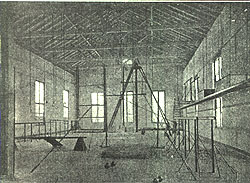 The Yale Gymnasium, 1860
Note the giant oblique ladder Martin probably exercised here |
JG Little Flatiron (1958) Photo ca. 1964 Click |
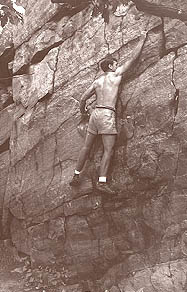 JG Tombstone (1958) Photo ca. 1964 |
| In 1926, Joe and Paul Stettner
began visiting Devil's Lake ,
Wisconsin, putting up top ropes on the steep quartzite cliffs and
pillars. During the 1950s modern gear made its debut and attitudes
began to change. Dave
Slinger, an Ol' Codger and wealthy onion farmer who
started climbing at the age of fifty, and who
loved to sand-bag the youngsters, developed a dynamic style, in
contrast to the meticulous static technique almost uniformly practiced
at the Lake. So Dave at least anticipated, if not actually engaged in
gymnastic bouldering on the smooth quartzite formations. During 1958-1959 I visited Devil's Lake several times, introducing my version of modern bouldering there, including the use of chalk. Dave and I shared a few chuckles . . . During the mid 1960s, Pete Cleveland put up several severe routes, including Phlogiston. Recollections of an Almost Boulderer by Michael Fain A First Climbing Trip . . .Devil's Lake, 1959 by John Stannard |
| Climbing began at Carderock,
near Washington, D.C., with visits by Gustave
Gambs (1868-1958). Manilla ropes and pitons were used,
both for leading and top-roping. Jan
and Herb Conn moved to the Washington area in the early
1940s and began climbing at Carderock. The Conns practised
on top ropes and performed longer, low-level traverses - the precursers
of actual bouldering. They established a newsletter for local climbers
entitled Up Rope in 1944. Much of the early
difficult climbing was done with
top ropes, including Herbie's
Horror
by Herb Conn (5.9),
done about 1943, Jam
Box (5.10 today) by Tony
Soler in the mid
1950s, and Silver Spot (5.10) by Mike Banks
in 1962. By the mid to late 1960s, a new generation of top climbers,
including Charlie Fowler,
Joe Faint, and John Stannard, were exercising
on the local rocks. Stannard probably created the first modern boulder
problems at Carderock. (Carderock: Past & Present, 1990) |
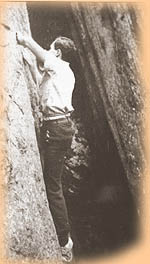 Herb Conn on Herbie's Horror, ca. 1943 Photo
Conn Collection
|
JG Sylvan Lake Boulder ca. 1962  JG & Bob Kamps mid 1960s Photo Bonnie Kamps |
In the Needles of South Dakota, starting in 1949, Jan and Herb Conn practiced long ground-level traverses when not making first ascents of spires. They wore cheap, low-top tennis shoes, tightly fitted and with the smooth rubber soles scored with a knife, and dried their hands with dry forest duff and pinecone powder. Herb and Jan usually climbed on a 60' rope, prefering the shorter length since it encouraged down-climbing, an important facet of the climbing experience as they saw it. (This practice was promoted in America by Fritz Wiessner, as well as Underhill and Henderson, during the 1930s, and was apparent in Whitney's climbing - due to G. W. Young's influence - as noted previously.) I began visiting the Black Hills in the mid 1950s, introducing modern bouldering there. From the late 1950s through the mid 1960s a number of (then) difficult problems were done on the coarse granite. Other climbers contributing substantially to Needle bouldering during the 1960s include Bob Kamps, Rich Goldstone, and Pete Cleveland. All the classic problems on the Sylvan Lake Boulder were done by the early 1960s. The Outlet Boulder was done a year or so later. |
| Climbers at Indian Rock in Berkeley practiced climbing moves and rope techniques starting in the 1930s. In the early 1930s, Dick Leonard developed the concept of the dynamic belay there, in order to save the leader from perishing due to a snapped sisal rope. This minute outcrop, surrounded by private homes, has seen continuous climbing/bouldering activity for over seventy years, including visits by many famous climbers. Nowadays, one can also see strange Berkeley-types there on occasion, like the gentleman I saw setting up toy soldiers on small ledges, along with a collection of coins, during the Iraq War. Important: be sure to empty your bladder before driving to the Rock - I'm told that the moist soil around the base has persisted since the early 1930s! |
Royal Robbins ca.1960 Photo Roger Brown |
Bob Kamps ca. 1960 Photo Roger Brown |
| Glen
Dawson and others in the Sierra
Club practiced ropework at Stoney
Point in California from
1935 on - but in the early 1950s a very youthful and extraordinarily
talented Royal
Robbins (see
his biography
Spirit of the
Age ) and his friends began clambering about on
the rocks, pushing
themselves on harder sections, both with and without ropes. These
bouldering
sessions in the early 1950s represent the first consistent
practice of a more
modern variety of bouldering in America. "By 1957, Stoney Point had become a regular weekend destination for the tight-knit climbing group that would push California technical roped-climbing standards to the highest in the world: Robbins, Frost, Chouinard, Rearick, Herbert, Kamps, and Powell." Stone Crusade by John Sherman. |
Bouldering in the Riverside area - namely, Mount Rubidoux and Big Rock - began as a stop-off activity for Royal Robbins and his friends on their way to Tahquitz during the 1950s. But, bouldering as a separate activity and not just a warm-up for bigger things probably got underway in the mid 1960s with efforts by Lee Harrel, a PhD historian I had met a few years earlier in Colorado. Paul Gleason, Keith Leaman, and Phil Gleason were early converts. The following is a short article by Phil, describing early bouldering evolution in the area . . . Early Bouldering in the Riverside Area by Phil Gleason |
Paul Gleason ca. 1965 Photo by Keith Leaman |
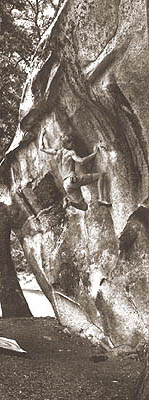 Midnight Lightning First Ascent 1978 Photo Stone Crusade |
In
Yosemite , though poorly chronicled, several
legitimate boulder problems had been established prior to 1950. The
Steck Overhang (5.10+) on Columbia Boulder was
done in the late 1940s, and challenged Robbins and friends as they
began climbing in the Valley in the early 1950s. During the 1950s and especially the 1960s a number of very difficult routes were climbed by Pratt, Ament, and others. "Pratt was not all that fired up about bouldering; he was just good at it. . . What the powerful Pratt excelled at were mantles . . . Ament was eager to do those mantles, he says,'because I thought they were the hardest routes in Camp 4. Hard bouldering mantles remained a Yosemite trademark throughout the 1960s and 1970s." - Stone Crusade by John Sherman One modern test-piece, Midnight Lightning, was done by Ron Kauk in 1978. Bachar and Kauk and others worked on this infamous problem for two months : ". . . Yablonski envisioned the line, then rushed over to Bachar and Kauk.. .'I found this new problem, man. It'll go Bachar and Kauk looked at it and shook their heads. . . they started working on the problem and making unexpected progress. . . soon the two were reaching the lip, but having no luck turning it. . . . Finally, on what promised to be another heel bruising day of attempts and failures, Kauk was again at the lip . . . he rocked over his right foot while popping a quick mantle with his left arm. He grabbed the finishing jug and the crowd fell into a shocked silence . . . " Stone Crusade by John Sherman. Nearby Tuolumne Meadows became a bouldering destination in the late 1950s and early 1960s, offering relief from the heat and crowds of Yosemite Valley. Kamps and others worked the knobs, reminiscent of the Black Hills Needles. Later, Bachar and Yerian discovered the Gunks, increasing the variety of available climbing. |
| It's
difficult to say
when the first actual bouldering began at Joshua Tree.
The Monument was created in 1936, and later Phil Smith -
Grand Teton's first Park Ranger, and author with Fritiof Fryxell of
many first ascents
there - and his son did some climbing at JT, joined by Jim Langford
when he was appointed ranger in the early 1960s. Randy Vogel informs me that he has learned that the Southern California Sierra Club RCS began making climbing trips to JT in 1950. Royal Robbins was an assistant leader on the November 1-2, 1952 trip to the Hidden Valley area. It appears that Royal, Mike Sherrick, Don Wilson, Frank Hoover, and others were in JT at least once a year throughout the 1950s, and it seems probable that they engaged in bouldering, since there are nice problems all around Hidden Valley CG. Documented modern bouldering activity appears to have begun with visits by John Long and John Bachar in the early 1970s. |
| Smoke
Blanchard, a Zen student and mountaineer, who favored
boots and alpenstocks, scrambled around the small summits above the
Buttermilks near Bishop, CA in the 1950s, and
about 1969 he introduced Doug
Robinson to the area. Doug may have been the
first climber to actually try
difficult moves on the monzonite boulders, although there is the
possibility
that Yvon Chouinard, Ken Weeks, and others might have visited the area
in the late 1950s. Doug and his friends treated the boulders more as a
spiritual haven than a competitive arena. Around 1980 John Bachar, and a little later, Dale Bard, began establishing modern competitive routes. The Happy Boulders - of volcanic origin - were discovered and explored much more recently. |
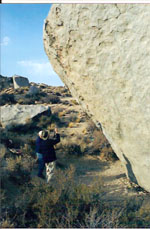 Photo Jody Langford |
Ray
Northcutt
Photo
Bernard Gilletteca. 2000 |
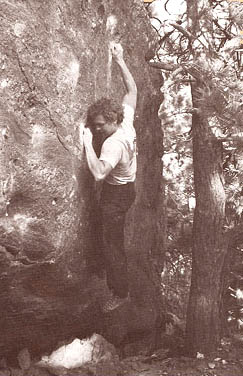 Pat Ament on Red Wall ca. 1978 Problem Done 1968 |
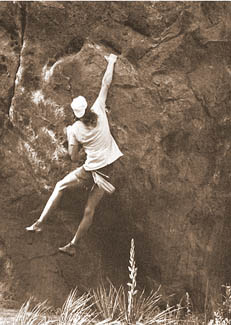 Holloway ca. 1976 Photo Pat Ament |
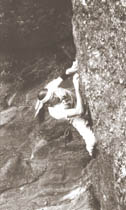 Jim Michael 1970s Photo Stone Crusade |
| Bouldering first occurred
on Flagstaff Mountain
in Boulder, Colorado, in the early to mid 1950s with the efforts
of Corwin Simmons,
Ray Northcutt,
Bob Culp
and a few others. Simmons was the first recognized Flagstaff boulderer,
working the sharp rock in the early 1950s. Some of those initial
Flagstaff Mountain problems may have been at least 5.10. A problem done
by Ray - a powerful competitor - on Cookie Jar Rock, called Northcutt's Roll,
is certainly greater than 5.10, and was ahead of its time. In the late 1950s and early 1960s the premier boulderer was the tall and strong Bob Culp, a salesman at Holubar's. Following Culp in the 1960s, the powerful gymnast Pat Ament led a group who raised these standards even higher. And then Jim Holloway appeared in the early to mid 1970s, setting standards that are still among the highest in the world. Bouldering at Flagstaff Mountain - the Early Years by Pat Ament. |
| Bouldering at Morrison,
near Denver, in its current form, began in the early 1970s with efforts
by Jim Holloway,
Jim Michael,
Steve Mammen,
David Breashears,
Bob Williams,
and others. The overhanging Dakota Sandstone invites a dynamic and
gymnastic technique. Some of the most severe problems on the Front Range are located here - the least repeated being routes by Holloway, seen here in the Black Hole in 1978. Some of Holloway's problems, here and at Flagstaff, were well into the 5.14 range. |
Jim Holloway 1978 Photo by Neal Kaptain |